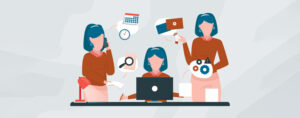Overcoming the challenges facing women entrepreneurs

Women are still under-represented in the professional world. While this has improved over time, it’s still not where it should be.
In fact, in stating the targets of the fifth Sustainable Development Goal, the United Nations pointed out that it would take another forty years before women can be equally represented in national governments as men.
As of Jan. 1, the global share of women in lower and single houses of national parliaments reached 26.2%, up from 22.4% in 2015. Women’s share is slightly over one-third in local governments, according to data.
Before the pandemic in 2019, women made up 39.4% of the workforce. Women then accounted for roughly 45% of worldwide job losses in 2020.
From 2015 to 2019, the percentage of women in managerial roles climbed from 27.2% to 28.3%. However, from 2019 to 2020, it did not change.
In the business world, at least, many women are taking charge of their own lives. In the United States, women founded over half of start-ups in 2021, according to Gusto, a cloud-based software provider for human resources.
According to the research, this represents a “dramatic leap” from the 28% of women who started new businesses in 2019. The main motivation for women to launch new firms in 2021 was to take advantage of “pandemic-related opportunities.” More than 2,600 new business owners responded to the survey.
This led to a record-breaking number of new businesses in 2021 — more than 5.4 million. The fact that this occurred while the nation was “in the midst of a once-in-a-century pandemic” is particularly astounding, according to Gusto’s 2022 poll of new business owners.
In the United Kingdom (UK), the online domain provider GoDaddy found that women are now running almost 40% of UK microbusinesses, up from 32% before March 2020, in its Venture Ahead research of 2.3 million microbusinesses in the UK.
Even in underdeveloped nations, female entrepreneurship is also on the rise.
According to the World Bank’s Female Entrepreneurship Resource Point, there are between 8 million and 10 million small and medium-sized businesses with at least one female owner throughout the developing world.
One-third of women work for themselves in unorganized jobs outside of agriculture across the globe. This is often small-scale, home-based, and targeted at industries like retail and services.
The prevalence of working from home has done wonders to enable women around the world, who are still expected to bear the burden of housework and childcaring responsibilities. Women who work from home are better able to “satisfy competing demands for their time,” according to the World Bank.
However, there are still many hurdles that women face as entrepreneurs today, including a lack of access to capital, biased hiring practices and even sexual harassment in the workplace. Lack of financial access and legal injustices, such as limitations on property ownership or management, are some of the challenges that women entrepreneurs in underdeveloped nations must overcome.
According to the World Bank, barely one in three enterprises worldwide are held by women.
Women entrepreneurs are less likely to get funding than men, and some studies have shown that this is worsened because there are fewer women investors. Women are also often overlooked for jobs because they do not fit the stereotype of a leader, and they are judged by their appearance rather than their achievements and accomplishments.
They also do not get the same opportunities as men do, which means fewer mentorships or sponsorship opportunities to help them advance in their careers.
Meanwhile, other global data also suggests that women are still more likely than males to be impacted by the pandemic.
The World Economic Forum (WEF) noted in its new Global Gender Gap Report 2022 that women have lost significantly more working hours than men since the pandemic’s height.
The demands of childcare and homeschooling contributed to women’s absence from the workforce. When jobs in industries like hospitality and retail have been lost, women have also been more negatively impacted.
As a result, women’s employment participation has decreased, from 60.1% to 51.7% this year.
Women’s wage equality slightly improved in 2022, due to the fact that women now make 2% more money than they did in 2021, whilst men now make 1.8% less money.
At ‘historic crossroads’
However, the report specified that it will still take 151 years until the gender gap in women’s economic opportunity and attainment is closed globally. The economic difference is far smaller than it was last year, when it was more than 260 years, but it is still far too wide, according to WEF.
Even in social entrepreneurship and nonprofit organizations, female leaders are faced with the challenges of maneuvering an industry heavily dominated by men, are discriminated against based on their appearance, are not listened to nor given decision-making power in group situations, and find that fund raising and networking efforts are easier for their male colleagues. This apparently goes even worse if these women are also discriminated due to race, indigenous background, or are disabled.
“We are at a historic crossroads, managing short-term pressures against medium- and long-term uncertainties. To shape a sustainable and inclusive recovery from the COVID-19 crisis, we need to include the voices of female social entrepreneurs who have decades of experience in changing systems and creating lasting impacts,” the WEF wrote back in 2021.
The Forum emphasized that even as many organizations attempt to achieve gender parity in the social entrepreneurship sector, it appears that there is a lack of a unified and coordinated strategy to address the unique requirements and demands of female social entrepreneurs. This is a systemic issue that requires a systemic response.
“A more gender-balanced system of social entrepreneurship promises not only to be fairer, but will also generate more impact. Systemic social problems can only be solved collaboratively across silos, whether they be sectors, institutions, geographies, classes, or identities. Tackling poverty at a local or regional level, for instance, requires that government, health, education, business, and many other sectors work together,” the Forum wrote.
“A more gender-balanced social innovation ecosystem will lead to more systemic approaches in social entrepreneurship. In such a scenario, not only do female social entrepreneurs thrive, but the world does, too.” — Bjorn Biel M. Beltran




